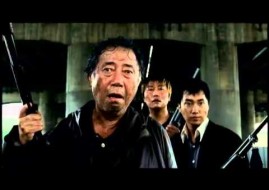Nightmare Scenario
Hollywood horror is creatively dead, but Asian films are reviving the genre.
[Guardian Unlimited]
Looking forward to Scary Movie 3: Lord of the Brooms? Or Halloween: Resurrection? Or how about Freddy Vs Jason, which doubles as Nightmare on Elm Street
Part Nine and Friday 13th Part 11? It’s clear that Hollywood’s horror industry is running scared. The formulas and franchises have been squeezed dry. And now Hollywood is turning to Asia to restock the cupboard – just as in earlier decades the American western was reinvigorated by Kurosawa’s samurai movies and the Hollywood action movie by Hong Kong cop thrillers.
In the next month, Dreamworks releases The Ring, a bona-fide supernatural horror movie revolving around a videotape that kills its viewers within seven days. US audiences may be unaware that this $60m film is a remake of the Japanese film, Ring (Ringu), directed by Hideo Nakata. Ring broke box-office records in Japan, Hong Kong and Singapore, spawning several sequels and a TV series. There was even a real-life funeral service in Tokyo last month, to lay to rest Ring’s ghostly star, Sadako. The film has also become a cult classic in Europe, but having optioned the rights, Dreamworks effectively ensured the Japanese original will not be released in the US.
In the UK, The Eye, an eerie Hong Kong horror film made by Thai brothers Oxide and Danny Pang is released next week. The premise is again hi-tech and supernatural: a blind patient sees for the first time thanks to a corneal transplant, but also inherits her deceased donor’s ability to see into the next world. Again, the heroine must trace the curse to its source. Again, The Eye has been a hit across Asia and the rights have been bought up by Hollywood (Tom Cruise and Paula Wagner) for a remake in pre-production. Meanwhile, in Japan, Ring director Hideo Nakata recently released his latest film, Dark Water; another creepy ghost story from Ring author Koji Suzuki. The remake rights have already been snapped up by former Fox studio boss Bill Mechanic, for his Disney-linked Pandemonium films.
Hollywood, prime exporter of horror for so long, is now building up a trade deficit. With a few important exceptions, (The Blair Witch Project and The Sixth Sense), US horror has had no new ideas since the slasher movies of the 1980s. While it was assumed that 1970s horrors such as The Exorcist and The Omen had inoculated audiences against fear of the supernatural, the terror in films such as Halloween, Friday the 13th and The Texas Chainsaw Massacre came from rational, if unlikely sources in familiar settings, but the stories became desperately predictable.
By the mid-1990s, Kevin Williamson’s self-aware Scream movies were a novel spin on slasher horror, but were hardly frightening. A few sequels and rip-offs later, we arrived at a dead end: pastiche efforts like Scary Movie.
This process of over-familiarisation could explain why the Asian strain is now so in demand. Where American slashers follow a numbing, killing rhythm, movies like Ring and The Eye take the opposite approach, using dread-filled silences, mysterious off-screen noises, grainy video and ambiguity, all building up to a devastating climax. The horror is achieved through editing, sound, composition, lighting and drama.
In addition, the new Asian horror movies blend their supernatural spookiness seamlessly into modern contexts. Videotapes and telephones are central to the plot of Ring; lifts and apartment buildings to Dark Water and The Eye. Other Japanese horror auteurs have followed suit. Takashi Miike provided a gruesome take on modern Asia two years ago with Audition, addressing Japanese society’s objectification of women, while Kiyoshi Kurosawa’s arthouse chiller Pulse investigates an internet-borne haunting, tapping into Japan’s anxieties about otaku – teenage boys who spend too much time in front of their computers (the original otaku was a teenage sex killer). The internet premise, coincidentally, crops up in recent Hollywood flop FearDotCom.
Despite this questioning of technological society, these films also draw on Asia’s rich supernatural tradition. The hauntings in Ring, Dark Water and The Eye all involve the spirits of women who have been unjustly killed, a recurring Asian cinematic theme in everything from Kenji Mizoguchi’s Ugetsu Monogatari to Tsui Hark’s Chinese Ghost Story series. They are part of an alternative supernatural universe that includes Chinese vampires (who jump rather than walk, and can be stopped with sticky rice or a scroll on the forehead), hideous tree demons (who use their long tongues to suck out humans’ yang ) and Daoist priests (who know medicine, feng shui and kung-fu, but are frequently alcoholics with bad teeth).
Ring could be considered a test for Asian-style horror abroad, but in many ways, foreign audiences have already adapted to it. The Blair Witch Project and The Sixth Sense, both followed the Asian pattern of slow-burning and became two of the biggest – and scariest – horror hits of recent years. The Sixth Sense’s (Indian-born) director, M Night Shyamalan’s Signs, currently number one in the UK, has taken more than $200m in the US. Last year’s The Others, another old-fashioned supernatural blockbuster, added to hopes of a full-blown suspense-horror revival.
The problem now facing Hollywood is that there’s nobody left to make these movies. Once, there was an established fraternity of reliably twisted directors to call on, but today’s Hollywood horror campus is simply a ghost town. Evil Dead director Sam Raimi has graduated to Spider-Man. Likewise Peter Jackson, who added the upended Flymo to the zombie killer’s arsenal in Braindead is now achieving universal renown with The Lord of the Rings. Likewise, body-horror veteran David Cronenberg is now craving arthouse respectability with the likes of Spider. Even Wes Craven, who brought us Nightmare on Elm Street and Scream, has directed Meryl Streep teaching underprivileged children to play the violin in Music of the Heart. Who’s left? Maybe John Carpenter, whose gung-ho action movies seem to be flogging the same undead horse.
For their Ring remake Dreamworks have enlisted Gore Verbinski, whose credits include Mouse Hunt, The Mexican and the Budweiser frogs commercial. Whether Chinese and Japanese horror will be lured to Hollywood remains to be seen. Not all of Hong Kong’s 1990s action community thrived there, and many have since returned home. Oxide Pang is moving further west with his next film, an English-language adaptation of Alex Garland’s The Tesseract, but says he no Hollywood ambitions.
Equally possible is that the new Asian horror movement will run out of steam. As a rule, Asian cinema is even more commercially driven than Hollywood. Before Ring, most supernatural staples had long been watered down into comic figures, especially in Hong Kong’s industry, whose vampire “comedies” make Scary Movie look like Oscar Wilde. Post-Ring, Japan has been flooded with Ring sequels (Nakata’s Ring 2 is the only good one), Ring spin-offs and Ring rip-offs. The chill factor is being diluted all the time.
But just as Kurosawa’s Samurai movies were influenced by John Ford’s westerns to begin with, so these new shockers have a clear debt to American horror like The Sixth Sense, or Stephen King’s novels. Whatever happens, it’s clear that, having considered ourselves jaded and unshakably rational viewers for so long, western audiences are becoming reacquainted with their capacity for superstition, irrational fear and spiritual dread. There’s always something to be afraid of.



















